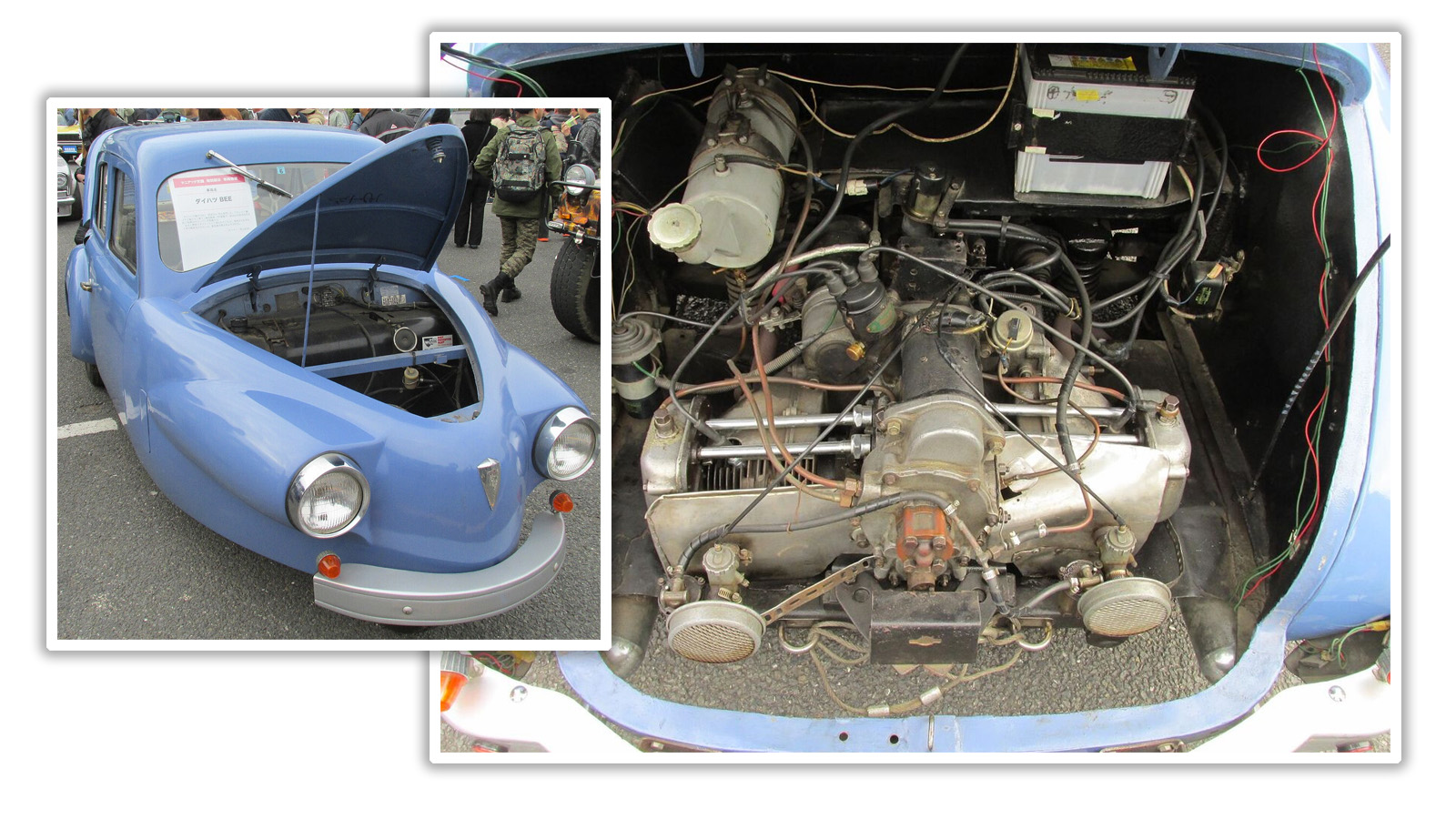
[ad_1]
See that strange little car up there? That funny little car up there is Daihatsu’s first passenger car, the Bee. The Bee wasn’t exactly a huge success. Built from 1951 to 1958, only about 300 Bees were built, though they seemed to have some popularity as taxicabs, because licensing for three-wheeled cars was cheaper than those having a lavish four wheels, like some kind of fancy-ass grocery cart. The Bee had a fiberglass body and was derived from Daihatsu’s three-wheeled pickup truck line, but had one significant difference that was a first for Japan, and was something that would come to define Subaru in later years. I’m going to make you wait for the next paragraph before I tell you, though, because I’m a jerk.

![]()
Okay, so here’s what the Bee’s big first was: it had the first horizontally-opposed engine used in a production Japanese car! This is, of course, a big deal for Subaru, because Subaru is one of the two remaining mass-market passenger car holdouts of the horizontally-opposed engine, with Porsche being the only other one. I believe they’re also the only current Japanese manufacturer of horizontally-opposed automobile engines, too, and it all started here, with the Bee. Look, you can see and hear for yourself:
Oh yeah, listen to that baby purr! It’s an interesting engine design, an air-cooled flat twin with twin sidedraft carbs mounted low. There were 540cc versions of this engine (known as the 2HA) that made a bit over 13 horsepower, and also a super-hot 804cc version that made a face-melting 18 hp. The valve pushrods are above the cylinders, the opposite of how a Volkswagen air-cooled flat-four engine does it, and it appears to be a bit more complex than a more famous flat-twin like the Citroën 2CV engine.
Interestingly, the finned cylinders don’t seem to be completely shrouded, like most air-cooled engines would be, with only a sort of air barrier between the cylinders and the carb.

Actually, now that I look closer at the engine, I think there is a fan mounted near the firewall there somewhere, perhaps co-axially with the generator, like a Beetle, and there seem to be some blower ducting around the cylinders, and they’re just open at the rear, exposing the cylinder fins.
There appears to be no sort of real trunk under the front hood, with just a fuel tank and the front wheel and steering mechanism living inside that tapered snout. I bet you could cram a soft bag on top of the fuel tank, though, if you needed to.

The Bee is surprisingly large and roomy-seeming for a three-wheeled car, with a full four-seat cab that almost looks like it could have had four doors. The interior floor is flat with no transmission hump, and it appears the rear windows roll down, too. Honestly, it looks pretty comfortable and airy in there!
The overall look is definitely a product of late 1940s jello-mold design, and from the A-pillar back, it’s really quite a conventional-looking car for the era. The single wheel up front demands a more tapered nose, and that’s where it gets more strange, culminating in a front bumper that would make an excellent parenthesis if you were building a big metal sign that demanded one.
 Also, note the odd little air-intake duct above the rear fender; most cars would use louvers or slots. That’s an interesting, almost aeronautical, choice.
Also, note the odd little air-intake duct above the rear fender; most cars would use louvers or slots. That’s an interesting, almost aeronautical, choice.
The suspension design seems to have been fairly advanced, too, at least from what I can gather from these diagrams:

The rear suspension seems to be independent, with some sort of double-arm setup on each wheel, and is compared to the solid live axle on a conventional car. Interestingly, this doesn’t seem to be a swing axle design as was so common on rear-engined cars of this era, like Porsche and VW and Tatra. The other diagram also shows off the Bee’s low floor, since it didn’t need to accommodate a driveshaft.

It’s definitely a cool little car, and it’s a shame it’s effectively unknown outside of Japan, really, Of the 300 or so built, only about three are known to survive, one of which has been restored and was written about almost exactly one year ago.
Horizontally-opposed engines have never been common in Japan outside of Subaru; that’s a big distinction to make, because Subaru very likely is the world’s largest producer of cars with such flat engines. Toyota may be the most visible other example of a horizontally-opposed car, with some Publicas and the coveted little gem, the Toyota Sports 800:

An interesting note to tie-in Subaru once again: with the introduction of the Toyota GT-86, a joint project with Subaru, the flat-four engine used there was technically classified by Toyota as part of their U-series of engines: the Sports 800 had a 2U, and the FR-S/BRZ/GT86’s Subaru-sourced engine was called by Toyota a 4U, putting in the same family as the old air-cooled flat twin of the Sports 800, even though all it shared was a general layout concept.
So, Subaru, I hope you’ve paid due respect to this interesting and humble little pioneer, the funny fiberglass vanguard of Japanese horizontally-opposed engine-crafting, the Bee.

As Usual, Daihatsu Schools Us All On How To Do Concept Cars Right
Is This The Smallest Car To Have An Opera Window?: Cold Start
The New Performance-Enhanced 2024 Subaru BRZ ‘tS’ Should Make Subaru’s Riotous Sports Coupe Even More Fun
[ad_2]